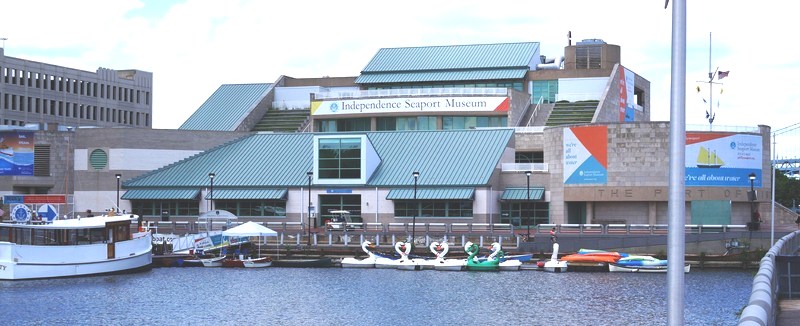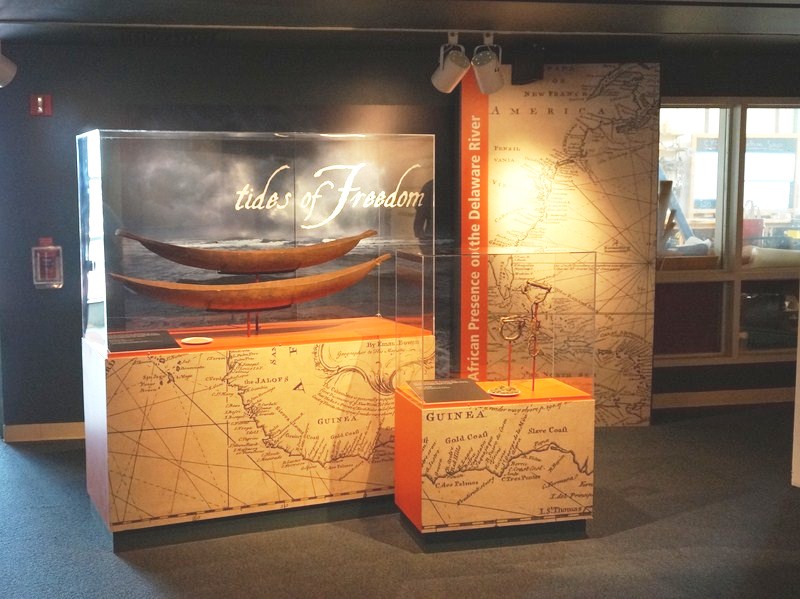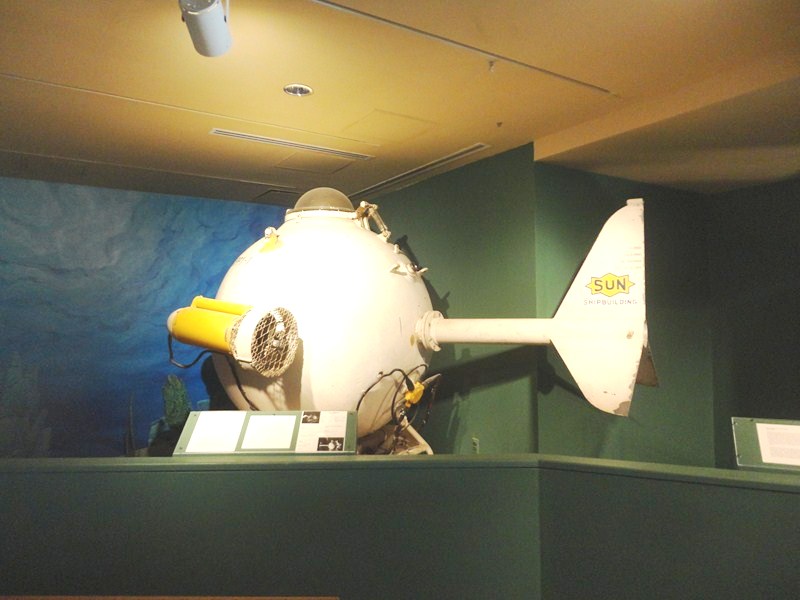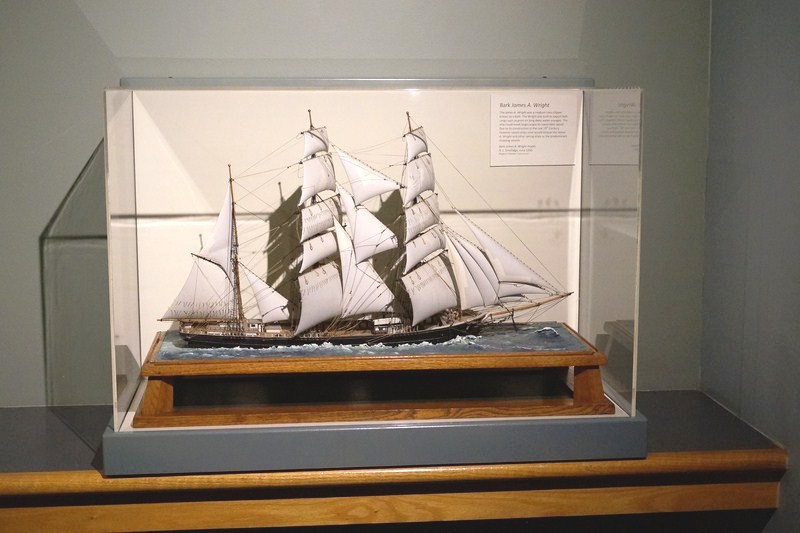The Independence Seaport Museum, formerly the Philadelphia Maritime Museum, is located in the Penn’s Landing complex along the Delaware River. Founded in 1961 by maritime collector J. Welles Henderson, the collections at the Independence Seaport Museum document maritime history and culture along the Delaware River. Along the waterfront of the museum are two National Historic Landmark ships – the cruiser USS Olympia (C-6), a Spanish-American warship that played a vital role in the Battle of Manila Bay, and the World War II and Cold War era submarine USS Becuna.
Check out “Independence Seaport Museum – USS Olympia” and “Independence Seaport Museum – USS Becuna“
The J. Welles Henderson Archives and Library, at the second floor of the museum, has a collection that focuses on maritime history and culture along the Delaware River and in the Port of Philadelphia, from early America to the present. The Archive includes personal and business records, rare books, reference materials, mechanical drawings, ship models, maps, art, architectural drawings, charts, recordings, photographs, cultural artifacts, and ephemera.
Notable items in the collection include the John Barry-Hayes collection, Reed & Ford business papers, Captain John Greene Collection, the Philadelphia Maritime Exchange records, and the collection of 16th–18th century geographical maps and charts. The Archive also maintains the cruiser Olympia and submarine Becuna collections. In August 2016 the Archive launched its first online catalog, which lists inventories of its archival collections.
The museum’s current exhibits are:
- The unique Patriots & Pirates, a exhibition developed by Chief Curator Craig Bruns and opened in April 2016, focuses on Philadelphia and the founding of the United States Navy. The permanent exhibition, highlighting the little-told story of America’s conflict with pirates features curated objects never, or rarely, seen by the public. It features a full-size, a stationary 102-ft. waterline model of the schooner Diligence of 1797 at the center. A vessel with masts soaring above a 62-ft. deck, it was constructed by staff and volunteers from Workshop on the Water, a traditional boat shop located inside the museum. Some notable artifacts in the exhibit include a rare letter written by American citizens held hostage in Algiers to the American Congress requesting for their return home (December 29, 1793), tools from the excavation of I-95 at Old City (Philadelphia) in 1974, Captain John Barry‘s octant, a painting of Philadelphia merchant ship Pigou being pursued by the French privateer L’Adventure and a model of the Federal St. Navy Yard, recreating Joshua Humphreys‘ shipyard in the 1790s where he built the frigate United States.
- Tides of Freedom: African Presence on the Delaware River, an exhibit curated by Tukufu Zuberi, (University of Pennsylvania professor of Sociology and Africana Studies) and opened in May 2013, explores African-American history along the Delaware River and focuses on the slave trade, emancipation and the abolitionist movement in Philadelphia, and Philadelphia’s connection to the underground railroad. The exhibit continues into the modern era, focusing on Jim Crow and Civil Rights in Philadelphia. On display at the exhibit are recently uncovered artifacts from the museum’s collection – slave shackles and an 18th-century account book that documents the sale of slaves in Philadelphia. Gripping first-person accounts and interactive elements provide visitors with opportunities for discovery and communication. Using four key moments in Philadelphia’s history, representing the themes of Enslavement, Emancipation, Jim Crow, and Civil Rights, urges visitors both to bear witness to a story central to Philadelphia and American history, and to think about the meaning of “freedom” both historically and in today’s world.
- Rescues on the River tells the story of maritime disasters along the Delaware River, exploring how tragedy shaped modern maritime safety regulations and led to the formation of the Coast Guard. The exhibit begins with a late 18th-century Revolutionary War-era explosion of a British ship and ends with the 1975 oil tanker collision and resulting fire. Explore the disasters that unfolded as the Delaware developed into a watery highway for trade and commerce while experiencing the misfortunes, the miracles and the lessons learned. It will also introduce historical prints and newspaper headlines that were used to broadcast and memorize these terrible marine catastrophes. Visitors to the exhibition can also take home a free 20-page tabloid keepsake, produced in partnership with the Philadelphia Weekly, which includes illustrations and more details about some of the events featured in the exhibition.
- Bound for Philadelphia, signaled by boat horns and whistles, makes visitors chart a course for Penn’s Landing. Learn the hazards of navigation as you travel beneath a three-story replica of the Ben Franklin Bridge and make your way along a carpeted Delaware River. View the charts and navigational instruments that helped guide early Delaware River travelers.
- The Navigation Exhibit, spotlighting navigation science, documents the critical role of navigation technology to maritime history. On display are collection of navigational tools from the early American colonial period to the present – sextants, compasses, maps, etc.. See how these objects made it easier to traverse the often difficult Delaware River.
Other past exhibits include:
- Titanic Philadelphiansopened in 2012, commemorated the 100th anniversary of the sinking of the RMS Titanic. The exhibit focused on the approximately 40 Philadelphian passengers of the Titanic, their first-hand accounts, and how their lives were forever altered by the tragedy. On display is a rare first class passenger list which was salvaged by Marian Longstreth Thayer who unknowingly had the list in her pocket as she boarded a lifeboat and whose husband died in the disaster.
- Coming to America spotlighted the experiences of immigrants who left their homeland for the United States and passed through Philadelphia’s Washington Avenue Immigration Station. On display are artifacts and oral histories of both wealthy first-class passengers and economically disadvantaged passengers traveling in steerage.
- Philadelphia and the China Trade chronicles the history of trade between the two nations (in the 18th century Philadelphia became one of the first American cities to begin trading with China) and explores the lasting impact it had on Philadelphia’s culture and economy.
Independence Seaport Museum: 211 S. Columbus Blvd., Philadelphia, Pennsylvania 19106, U.S.A. Tel: +1 215-413-8655. Website: www.phillyseaport.org. Open daily, 10 AM – 5 PM. Closed on Thanksgiving Day and Christmas Day but open on New Year’s Day, Martin Luther King Day (January 15) and President’s Day (February 19). Admission: US$16 (adults), US$12 (seniors, 65 & over), US$12 (children, 3–12 years old), free for college students, military (active & retired) and children 2 years old & under. Seafarin’ Saturday and Citizen Science Lab programming are included with regular admission. Group visits are available at reduced rates for a minimum of ten people. Reservations must be made in advance.










Pingback: The Moshulu (Philadelphia, Pennsylvania, USA) – B.L.A.S.T. – Live Life to the Fullest ……… Don't Stay Put